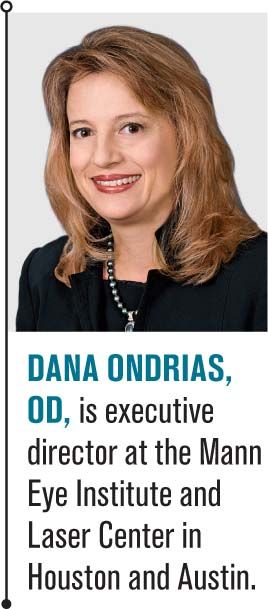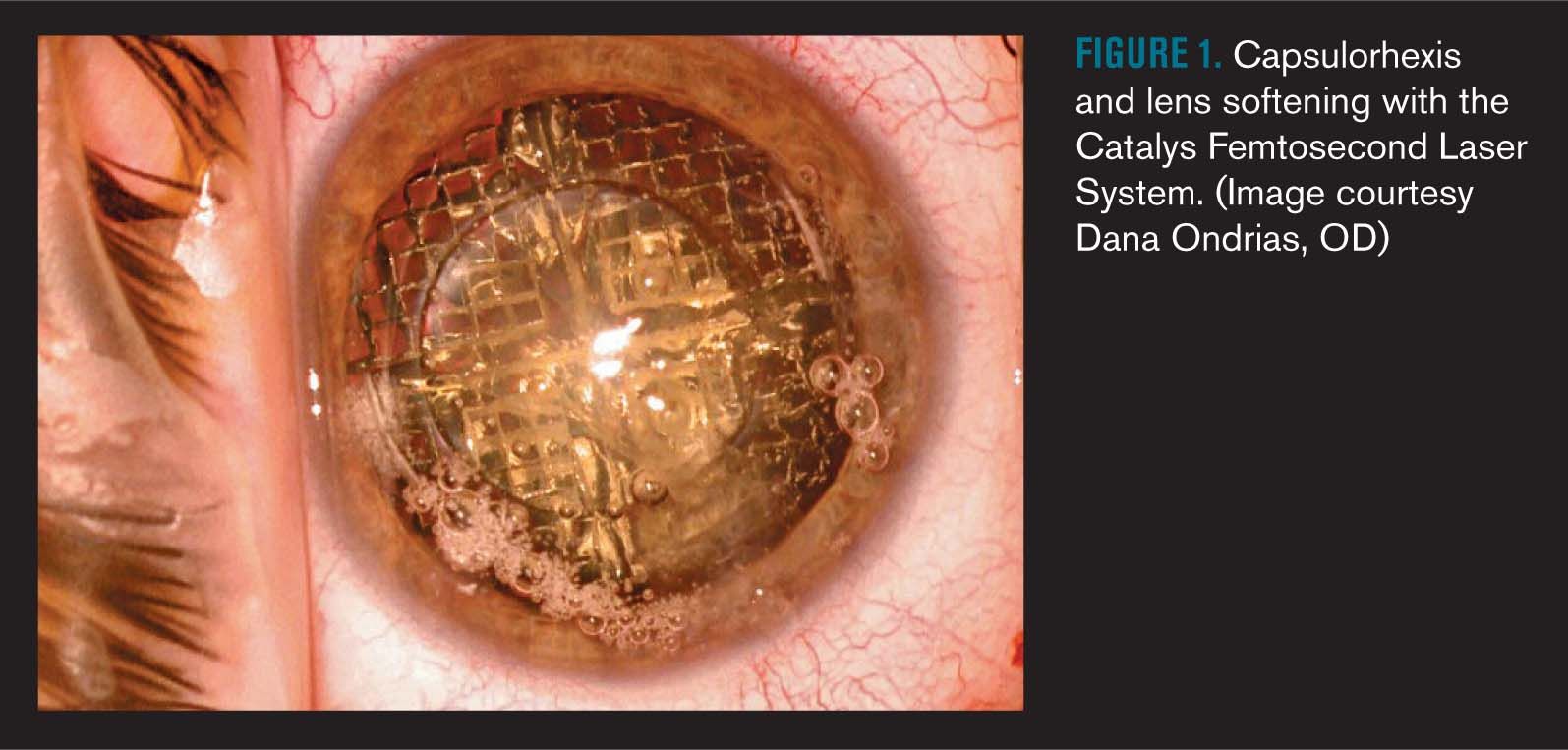Integrating laser cataract surgery
The landscape of cataract surgery has changed rapidly-first with premium intraocular lenses (IOLs) and now additional refractive cataract options such as laser-assisted cataract surgery (LACS) and intraoperative aberrometry.

The landscape of cataract surgery has changed rapidly-first with premium intraocular lenses (IOLs) and now additional refractive cataract options such as laser-assisted cataract surgery (LACS) and intraoperative aberrometry.
With so many changes in technology, the choices that patients have to make, and the expectations they have for refractive outcomes, optometrists need to know how to counsel patients in this new environment. I think patient counseling is just as important for optometrists who refer patients for cataract surgery as it is for those of us working in surgical practices.
Mann Eye is an integrated OD-MD practice, but we also comanage with several external optometrists.
From our perspective, it is critical that patients hear consistent messages about how new technology may be able to benefit them. That is best achieved when referring doctors themselves are well educated about cataract surgery, LACS, and what to expect at our facility.
Related: Innovations in cataract and refractive surgery
The ideal comanagement scenario is one in which the patient is happy with his doctor’s knowledge and guidance, happy with the surgical experience, and achieves outstanding visual results. That is a patient who will rave about the results, refer friends and family, and return to the knowledgeable doctor who took such good care of him. Both the surgeon and the optometrist look good-and neither has to deal with extensive chair time.

Integrating LACS in our practice
Once our practice decided to move into the laser cataract space, we carefully evaluated the LACS systems on the market. After practice site visits and seeing assembly plants for several, we ultimately selected the Catalys Femtosecond Laser System (Abbott Medical Optics).
My job then was to figure out how to integrate the laser into our clinical flow and how to educate staff, referring clinicians, and patients. As the first practice in the U.S. to acquire this laser, we really had to blaze our own trail.
I created a timeline and a training plan, which we have since used as a template for other new technology acquisitions, including the LipiFlow thermal pulsation system (TearScience) and the ORA intraoperative aberrometer (WaveTec).
The first task, well in advance of acquisition, was to determine how LACS would affect our surgery center. We needed to determine which entity would actually purchase and own the laser, whether any space build-out or HVAC changes would be required, and how we would track and bill for use of the laser. We also had to do some financial modeling to determine our goals and structure our fees.
We decided to install the femtosecond laser in one of two operating rooms (ORs) at our Houston surgery center. Surgeons alternate between the two rooms. With multiple instrument sets and an efficient break-down team, we have been able to keep the patient flow moving quickly so that LACS didn’t slow us down for long.
Next: Train in stages
Train in stages
Education and training is essential to a smooth and successful rollout of any new technology. We approached this in stages. The top priority-before the laser arrived and immediately after-was internal education for our doctors and managers. The five surgeons needed certification and to feel comfortable with the laser, and managers needed to plan how to implement changes in their departments.
Next, we began training the rest of our internal staff. The lead surgeon for LACS integration, Paul Mann, MD, and I visited each of our locations. We used slides, videos, and 3D eye models to educate the entire staff-including front desk and clerical staff-about how the laser creates a capsulotomy and treats the lens and the differences between conventional cataract surgery and LACS.
Related: Comparing laser-assisted vs. conventional refractive cataract surgery

This road trip turned out to be a critical piece of our rollout, primarily because it very effectively conveyed the surgeon’s enthusiasm for LACS to everyone on staff. Additionally, we found that some of our nonclinical staff had only rudimentary knowledge about conventional cataract surgery, let alone femtosecond laser.
These staffers aren’t directly educating patients, but becoming more knowledgeable about cataract surgery has made them better advocates for the practice and LACS when they do interact with patients.
The receptionist will tell patients to be sure to ask about the new laser treatment, and the billing clerk will ask a postop patient whether she just loves how her premium lens and laser surgery turned out. What I love is that patients hear the excitement at every touchpoint in the practice.
At each location, we also provided more intensive technical training for the clinical staff and targeted training for the patient counselors to help them translate femtosecond laser capabilities into the benefits that matter to patients.
Once all our staff was trained, we began internal marketing efforts to educate our patients about LACS. This included working with a local firm to develop patient education animations.
Finally, with several months of experience under our belts, we directed our education efforts to comanaging optometrists outside the practice. In addition to large, open-house seminars, we invited key referral sources for smaller dinner sessions so they could hear the surgeons’ personal opinions and have an opportunity to ask more detailed questions about clinical expectations.
Related: The refractive surgery future for cataract patients
It is really important for optometrists to have candid conversations with the surgeons about LACS-or any new technology. The optometrist needs to know what to expect in terms of follow up, additional testing, or education, as well as differences in clinical presentation. Because the optometrist is often the first to speak with the patient about LACS, she needs to be completely comfortable addressing the extra cost and conveying the value of LACS for specific types of patients, such as those receiving a toric or presbyopia-correcting IOL.
Next: Practice impact
Practice impact
We decided early on that we wanted to achieve a LACS penetration rate for the practice that was 10 percent above our average premium IOL conversion rate, and we quickly exceeded that goal. Today, the conversion rate to LACS varies by surgeon, from about 10 percent to 30 percent above premium IOL rates. Our new “stretch” goal is for 70 percent of our eligible cataract surgery procedures to be LACS procedures.
We paid for the laser within six months, which was faster than we expected to break even. Overall, cataract surgical volume is up. Access to the femtosecond laser has also somewhat shifted the balance of premium IOLs in the practice to more toric lenses.
Related: Why wait to recommend cataract surgery?
The areas of greatest adjustment were in our patient flow and pricing menu, both of which changed several times during the integration process and/or over the first year. For example, we moved from an “astigmatism management” package to what we now call our “refractive management” package, partly as we adjusted to the laser and partly to accommodate other new technologies.
The current refractive management package includes any tools or secondary procedures the surgeons deem necessary for good distance vision without glasses. We also offer an all-distance vision package, which includes a presbyopia-correcting IOL and what surgeons suggest for good vision at all distances.
We don’t think that LACS adds much of a burden for comanaging optometrists. In fact, if patient education is comprehensive on the front end, there shouldn’t be much added chair time postoperatively. However, we have extended the postop global period from 90 to 180 days to cover additional visits for refractive cataract surgery and compensate referral sources for the extra time in patient education and refractive management.
Next: Do your homework
Do your homework
With more surgery centers acquiring femtosecond lasers, this is a great time for optometrists to explore the LACS offerings in their local area. Find out what equipment is available and what packages different centers are offering. Does the center use the laser only with premium lenses? Is the procedure termed “laser” cataract when in fact advanced technology but not a femtosecond laser is employed?
Related: Effectively comanaging femtosecond laser-assisted cataract surgery
I would strongly recommend taking the time to watch surgery at any center where you are considering referring patients. There is great value in seeing how the staff takes care of patients.
Also, you will gain firsthand knowledge of the tiny details that are reassuring to patients: where to park, whether relatives can be present for the surgery and where they will wait, and how many weeks patients can expect to wait between the first and second eye surgery.
To build and maintain a strong practice, it is essential that patients perceive their doctor is knowledgeable and has their best interests at heart. Taking a few minutes to convey your educated impressions about LACS and the surgical choices available to patients will always pay off in the long run.
Newsletter
Want more insights like this? Subscribe to Optometry Times and get clinical pearls and practice tips delivered straight to your inbox.